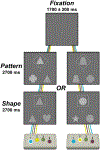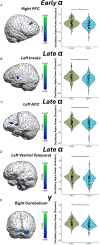People with HIV exhibit spectrally distinct patterns of rhythmic cortical activity serving cognitive flexibility
- PMID: 39326464
- PMCID: PMC11525061
- DOI: 10.1016/j.nbd.2024.106680
People with HIV exhibit spectrally distinct patterns of rhythmic cortical activity serving cognitive flexibility
Abstract
Despite effective antiretroviral therapy, cognitive impairment remains prevalent among people with HIV (PWH) and decrements in executive function are particularly prominent. One component of executive function is cognitive flexibility, which integrates a variety of executive functions to dynamically adapt one's behavior in response to changing contextual demands. Though substantial work has illuminated HIV-related aberrations in brain function, it remains unclear how the neural oscillatory dynamics serving cognitive flexibility are affected by HIV-related alterations in neural functioning. Herein, 149 participants (PWH: 74; seronegative controls: 75) between the ages of 29-76 years completed a perceptual feature matching task that probes cognitive flexibility during high-density magnetoencephalography (MEG). Neural responses were decomposed into the time-frequency domain and significant oscillatory responses in the theta (4-8 Hz), alpha (10-16 Hz), and gamma (74-98 Hz) spectral windows were imaged using a beamforming approach. Whole-brain voxel-wise comparisons were then conducted on these dynamic functional maps to identify HIV-related differences in the neural oscillatory dynamics supporting cognitive flexibility. Our findings indicated group differences in alpha oscillatory activity in the cingulo-opercular cortices, and differences in gamma activity were found in the cerebellum. Across all participants, alpha and gamma activity in these regions were associated with performance on the cognitive flexibility task. Further, PWH who had been treated with antiretroviral therapy for a longer duration and those with higher current CD4 counts had alpha responses that more closely resembled those of seronegative controls, suggesting that optimal clinical management of HIV infection is associated with preserved neural dynamics supporting cognitive flexibility.
Keywords: Hierarchical cognitive control; Higher-order cognition; Magnetoencephalography; Oscillations; Perceptual feature matching.
Copyright © 2024 The Authors. Published by Elsevier Inc. All rights reserved.
Conflict of interest statement
Declaration of competing interest SHB reports scientific advisory to Gilead Sciences and research grants to her institution from ViiV Healthcare and Janssen. All other authors declare that they have no known competing financial interests or personal relationships that could have appeared to influence the work reported in this paper.
Figures






Similar articles
-
The neural oscillations serving task switching are altered in cannabis users.J Psychopharmacol. 2024 May;38(5):471-480. doi: 10.1177/02698811241235204. Epub 2024 Feb 28. J Psychopharmacol. 2024. PMID: 38418434 Free PMC article.
-
Epigenetic aging is associated with aberrant neural oscillatory dynamics serving visuospatial processing in people with HIV.Aging (Albany NY). 2022 Dec 15;14(24):9818-9831. doi: 10.18632/aging.204437. Epub 2022 Dec 15. Aging (Albany NY). 2022. PMID: 36534452 Free PMC article.
-
Cannabis use impacts pre-stimulus neural activity in the visual cortices of people with HIV.Hum Brain Mapp. 2021 Nov;42(16):5446-5457. doi: 10.1002/hbm.25634. Epub 2021 Aug 31. Hum Brain Mapp. 2021. PMID: 34464488 Free PMC article.
-
Altered Functional Connectivity Dynamics Serving Cognitive Flexibility in Regular Cannabis Users.Addict Biol. 2025 Feb;30(3):e70023. doi: 10.1111/adb.70023. Addict Biol. 2025. PMID: 40042248 Free PMC article.
-
Aberrant occipital dynamics differentiate HIV-infected patients with and without cognitive impairment.Brain. 2018 Jun 1;141(6):1678-1690. doi: 10.1093/brain/awy097. Brain. 2018. PMID: 29672678 Free PMC article.
Cited by
-
Cannabis- and HIV-related perturbations to the cortical gamma dynamics supporting inhibitory processing.Brain Commun. 2025 May 15;7(3):fcaf190. doi: 10.1093/braincomms/fcaf190. eCollection 2025. Brain Commun. 2025. PMID: 40421314 Free PMC article.
References
-
- Anderson AM, Pérez-Santiago J, Zheng Z, Huang E, Franklin D, Iudicello J, Moore DJ, Ellis RJ, Heaton RK, Letendre SL, 2019. Better executive function is independently associated with full HIV suppression during combination therapy. AIDS 33, 2309–2316. 10.1097/QAD.0000000000002348. - DOI - PMC - PubMed
-
- Antinori A, Arendt G, Becker JT, Brew BJ, Byrd DA, Cherner M, Clifford DB, Cinque P, Epstein LG, Goodkin K, Gisslen M, Grant I, Heaton RK, Joseph J, Marder K, Marra CM, McArthur JC, Nunn M, Price RW, Pulliam L, Robertson KR, Sacktor N, Valcour V, Wojna VE, 2007. Updated research nosology for HIV-associated neurocognitive disorders. Neurology 69, 1789–1799. 10.1212/01.WNL.0000287431.88658.8b. - DOI - PMC - PubMed
-
- Arif Y, Wiesman AI, O’Neill J, Embury C, May PE, Lew BJ, Schantell MD, Fox HS, Swindells S, Wilson TW, 2020. The age-related trajectory of visual attention neural function is altered in adults living with HIV: a cross-sectional MEG study. EBioMedicine 61, 103065. 10.1016/j.ebiom.2020.103065. - DOI - PMC - PubMed
MeSH terms
Grants and funding
LinkOut - more resources
Full Text Sources
Medical
Research Materials

